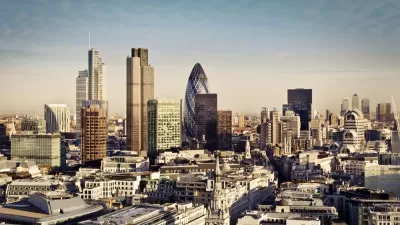An essay identifies imperatives for a new theory of tall, dense construction, and begins to sketch out a theory that will reconcile the skyscraper with contemporary business ideals.

Diana Lind's essay from the book The Future of the Skyscraper is available in full on Medium. Lind joins a distinguished group of writers in that book, with an essay that tests "the idea of building tall against the more sprawling needs of new industries."
Lind launches the essay's argument by citing the emblematic design of Facebook's headquarters, an adaptive reuse of the suburban office park once used by Sun Microsystems. The campus, argues Lind, embodies the tenants of New Urbanism, which is not necessarily a good thing. "This kind of deceptive architecture, devoid of theory but heavy on fantasy, has become not just the norm but a vogue of our times," writes Lind. "While contemporary aesthetics may profess to aspire to authenticity, the real and the sincere are often confused today with a fetishization of the past."
Moreover: "At a time of increasing resource scarcity and environmental stress, we should be shunning office parks like that of Facebook’s, built a ninety-minute car commute from the urban core where most of its employees live. With population growth and rising rents showing no sign of abating, low-density, New Urbanist designs simply cannot accommodate the demand of more than seven billion people on the planet."
The question posed by the essay is how to reconcile the skyscraper, assuming it brings economic, social, and environmental benefits, with the aesthetics of contemporary business. Some of that potential for reconciliation, according to Lind, acknowledges the shortfalls of how skyscrapers have been built in New York and other cities. Lind even agrees with the teachings of New Urbanism on the common skyscraper's negative effect on the human experience of the street.
To start the skyscraper on a path to rebirth, Lind suggests a surprisingly obvious concept: style. According to Lind, "[i]t is imperative that a new theory for skyscrapers be developed, one that will accommodate our culture’s values."
Read through the article for more on what that theory looks like.
FULL STORY: The Form Could Be Reborn

Maui's Vacation Rental Debate Turns Ugly
Verbal attacks, misinformation campaigns and fistfights plague a high-stakes debate to convert thousands of vacation rentals into long-term housing.

Planetizen Federal Action Tracker
A weekly monitor of how Trump’s orders and actions are impacting planners and planning in America.

San Francisco Suspends Traffic Calming Amidst Record Deaths
Citing “a challenging fiscal landscape,” the city will cease the program on the heels of 42 traffic deaths, including 24 pedestrians.

In U.S., Urban Gondolas Face Uphill Battle
Cities in Latin America and Europe have embraced aerial transitways — AKA gondolas — as sustainable, convenient urban transport, especially in tricky geographies. American cities have yet to catch up.

Detroit Says Problems With Property Tax Assessments are Fixed. Advocates Disagree.
With higher-valued properties under assessed and lower-valued properties over assessed, advocates say there's still a problem with Detroit's property tax system.

Defunct Pittsburgh Power Plant to Become Residential Tower
A decommissioned steam heat plant will be redeveloped into almost 100 affordable housing units.
Urban Design for Planners 1: Software Tools
This six-course series explores essential urban design concepts using open source software and equips planners with the tools they need to participate fully in the urban design process.
Planning for Universal Design
Learn the tools for implementing Universal Design in planning regulations.
Heyer Gruel & Associates PA
JM Goldson LLC
Custer County Colorado
City of Camden Redevelopment Agency
City of Astoria
Transportation Research & Education Center (TREC) at Portland State University
Jefferson Parish Government
Camden Redevelopment Agency
City of Claremont





























